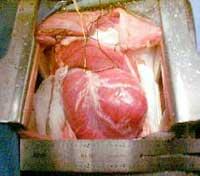Occlusive aorta balloon in cardiopulmonary resuscitation
J. M. According to Labandeira results, an occlusion balloon established in the aorta doubles the blood pressure that reaches the brain and heart in cardiopulmonary resuscitation movements.
Improve CPR results

Cardiopulmonary resuscitation (CPR) movements are emblematic actions of emergency services since the 1960s, the year of its creation. These movements serve to ventilate the patient and simultaneously apply chest compressions. However, although CPR is performed in the best possible way, the blood moving is very scarce (the discharge of blood does not reach 50% of normal measures). To increase the amount of blood that reaches the two most important organs, the heart and brain, new techniques are being attempted.
In order to improve the results of the CPR, Jesús Manuel Labandeira has done something similar to a short circuit. Through the groin, through the femoral artery, a balloon-supported catheter is inserted and downstream of the diaphragm is located in the aorta. By inflating the ball it is possible to separate the blood only to the strictly necessary places. In this way, the blood that comes out of the heart is directed only to the brain or heart, avoiding displacement to the extremities and other non-basic parts of the body.
The Navarrese doctor believes that with the introduction of a balloon into the aorta the blood pressure that reaches the heart and brain almost doubles. Aorta blood pressure produces a similar phenomenon. When a person is alive, his blood pressure is usually 120 mm systolic Hg and 80 mm diastolic Hg (120/80). At the start of a CPR standard the values range around 41 mm systolic Hg and 20 mm distolic Hg (41/20). Using the balloon, 74 mm of systolic Hg and 39 mm of diastolic Hg (74/39) are obtained. They are modest measures but with the ball it is possible to double the results of a normal CPR.

J. M. The conclusions of Labandeira's thesis show that the intraortic occlusion balloon increases the systolic, diastolic and mean arterial pressures, as well as the pressure of coronary and brain perfusions. To achieve better results it is very important to use the new technique quickly. In addition J. M. After Labandeira's necropsis of pigs, the experiment did not cause any damage to these animals, neither in their viscera nor in their vascular structures.
Experiment with 14 pigs
Labandeira has conducted the study with 14 pigs. This animal is the most similar to humans in the cardiovascular field.
The pig, once anesthetized so that he did not suffer, was subjected to a cardiorespiratory stop thanks to a ventricular fibrillation. The CPR is then started. Each pig, with and without internal aorta occlusion ball, had four five-minute applications. The results of the balloon experiments were better.
If you plan to use this system with humans, assimilating a ball to the aorta is not so difficult technically. The feromal artery is easily accessible and the catheter can penetrate in less than five minutes.
J. M. Labandeira's thesis has been approved for publication in the scientific journal American Journal of Emergency Medicine. Two other research groups are currently investigating this issue, one in Sweden and one in the United States.
Buletina
Bidali zure helbide elektronikoa eta jaso asteroko buletina zure sarrera-ontzian











